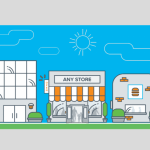iQor, a global provider of customer care and interactions, and Business Process Outsourcing (BPO) solutions, released the results of their “Customer and Product Experience 360” survey focusing on early adopters of connected devices like smart refrigerators, thermostats and speakers.
Autumn Braswell, iQor’s Chief Operating Officer, shares a few of the key findings of the survey, and how growing expectations for using connected devices are forcing companies to up their game and provide better customer experiences and journeys in order to keep them excited about the potential these devices have.
Below is an edited transcript of our conversation. To see the whole interview click on the video below, or on the embedded SoundCloud player.
* * * * *
 Small Business Trends: We’re gonna talk about the results of this really interesting survey you guys did. It’s called, “Customer and Product Experience 360.” And it’s a survey that you guys put on. Some of the really interesting results that came out of it, particularly when it comes to the whole smart home, and the connected devices, and kind of the first adopter of these folks, and get into some of the interesting tidbits of it.
Small Business Trends: We’re gonna talk about the results of this really interesting survey you guys did. It’s called, “Customer and Product Experience 360.” And it’s a survey that you guys put on. Some of the really interesting results that came out of it, particularly when it comes to the whole smart home, and the connected devices, and kind of the first adopter of these folks, and get into some of the interesting tidbits of it.
Small Business Trends: Tell us a little bit more about iQor.
Autumn Braswell: iQor is a really interesting company that probably no one has ever heard of. We’re the name behind a lot of brands. In practical terms what we do for our clients [original equipment manufacturers, carriers, media companies, financial services] is every customer touchpoint; customer acquisition, if they’re doing retention and loyalty services, technical support, even some back office work. But then, we also handle the product journey. Any time there’s actually something wrong with your device, a lot of the time we’re the ones that get it back, and repair it, get it back to you, or have one there for you if they’re doing kind of an advanced exchange.
There’s a lot of companies that do either the customer side, or the product side. But, we combine both, which is why this survey was so interesting to us.
Small Business Trends: Tell us a little bit more about the survey, and particularly why did you decide to do it now?
Autumn Braswell: Because we have the privilege of covering a lot of different market verticals, and also a lot of the different players in those verticals, we actually have an interesting kind of bird’s eye view of the ecosystem; and Connected Home specifically is becoming a very complex ecosystem. And so, we saw a lot of the inefficiencies, and customer frustration in having to deal with multiple companies, if something was wrong with a device. And also, this lack of data following the customer, so a lot of repeat. And then, what we also see in our depot, depending on the product, we’ll see up to 60% of the devices with actually nothing wrong with them.
We knew there was a lot of frustration and leakage in the system, and so we wanted to hear from the consumers point of view, kind of where did they have frustration, what was their journey, and what was their kind of preferred method of being serviced.
[youtube https://www.youtube.com/watch?v=4bznLGUIMVo?rel=0]
Small Business Trends: Give us the key takeaways, and maybe even some of the surprising findings that came out of this.
Autumn Braswell: We kind of knew that they were having to deal with multiple parties if they had an issue to be resolved, and that was validated, that they were having to deal with two to three different companies over three different sessions, and three different people they were talking to. So, we got to validate that point.
They typically went through eight different items on that service journey, so eight different places starting with self-help, and then entering the customer service at a certain point. So that was very interesting, that they were spending an hour and a half of their own time doing self-help. And then an additional hour with service and support.
But one of the more interesting elements is we gave them a list of 20 different things they could do, everything from read the manual, ask a friend, all the way through to ultimately calling the customer service number. And we asked them to rate that from two lenses – one is convenience, and the other being effectiveness. And, the top-rated way that was most effective and most convenient, was YouTube. The fourth most convenient and effective was expert crowd forums. I think those two things really speak to both the digital means in which people like to engage in self-help with the video content, but also how we have to start thinking about the crowd sourcing element, and helping service our customers.
Small Business Trends: The folks that participated in this survey, these are folks that are early adopters. Maybe you could just give us a little bit of the profile of what these folks are like.
Autumn Braswell: Maybe it shouldn’t have been so surprising to us. We had over 6,000 folks come into the survey, and in order to participate in the survey they had to have a mobile phone, and not a feature phone like a smartphone. They had to have a computer or laptop, and then they had to have at least two connected devices in their home. And it could be anything, a connected thermostat, connected light bulbs, or a Wink system. They had to have at least two of those. And then ultimately, we were looking for folks that had a problem in the last few years, some support related event.
When we got through the demographics of those folks, our demographics ended up being about 59% early adopters. Where in the normal kind of population curve, you’d see about 17%. And so, I think, thinking about the folks that we were actually having do this survey, are those that are tech savvy. That are interested in technology, that typically don’t have a problem. So to see so many of them have an issue in the last two years, and primarily around installation and setup, just really speaks to the fact that if the connected home providers want to see this mass adoption that we all want, and to accelerate that, we really have to make it a lot easier out of the box, first of all. And second of all, kind of think about the ecosystem these things are living in, and how do we create content in a way that helps them kind of get them up and running very quickly.
Small Business Trends: I consider myself an early adopter. I’ve got a lot of connected things in my house. One thing that jumps up to me, and I guess I kind of fall into this too, is I actually did look at the manual ’cause I couldn’t get it to work out. I actually did look at the manual. But, how are the expectations and behaviors changing when it comes to using these home technologies, these connected devices. How is that changing the expectations of customers? It seems like you guys had a lot of early adopters, so how is it changing early adopters expectations for using these kind of devices?
Autumn Braswell: Yeah, and I can’t believe you also read the manual… We were surprised to see that 59% of our respondents, that was the first place they went. I didn’t even know they existed anymore. [laughter]. But, the expectations with consumers is at an all-time high. There was a case, a time, even with the initial smartphones, where I think people were a lot more patient in trying to understand, “What is this going to do for me?” But, consumers have this expectation that these connected devices are going to work together seamlessly, it’s going to create a very personalized experience for them.
When I tell Alexa to turn on my Hue light bulbs, and turn down my thermostat, that all of that works very seamlessly. So the expectations are extremely high, but the ecosystem hasn’t caught up with that yet. The companies still are having to work through multiple protocols between the devices, and also thinking about this, less about the point solution, like connecting my thermostat. And more about, how does the thermostat live in the entire home.
Small Business Trends: All right, so I mean there’s a lot of things going on, and there’s a lot of moving parts. But, it’s not necessarily a nice to have, it’s almost a need to have in terms of engaging your customers and prospects through some of these devices and ecosystems. So, how do companies that haven’t gotten started but know they need to get going, how do they do it the right way so that they create the kind of experiences and journeys that customers are expecting today?
Autumn Braswell: I would say that you start by understanding that consumers expectations of that device, not just as a single device, but how is it expecting it to interact with the rest of the home. I think map out the customer journey, you know? That’s not a new tactic, but the customer interaction or touchpoints with the brand are no longer just single points, or a single stream. But, there in multiple different places, and understanding what does that mean, and meeting the customer where they want to be met, you know? We talked about different mediums, and consuming things the way they want. You have to think about that a lot more wholistically, so when you create a piece of service content, you must deliver it both in video, deliver it in an FAQ, arm these crowdsourcing experts with that information.
And so, I think it’s just thinking about the service more wholistically, and to your point, really understanding that customer’s expectation of that device, and making it pretty seamless out of the box.
[“Source-smallbiztrends”]




